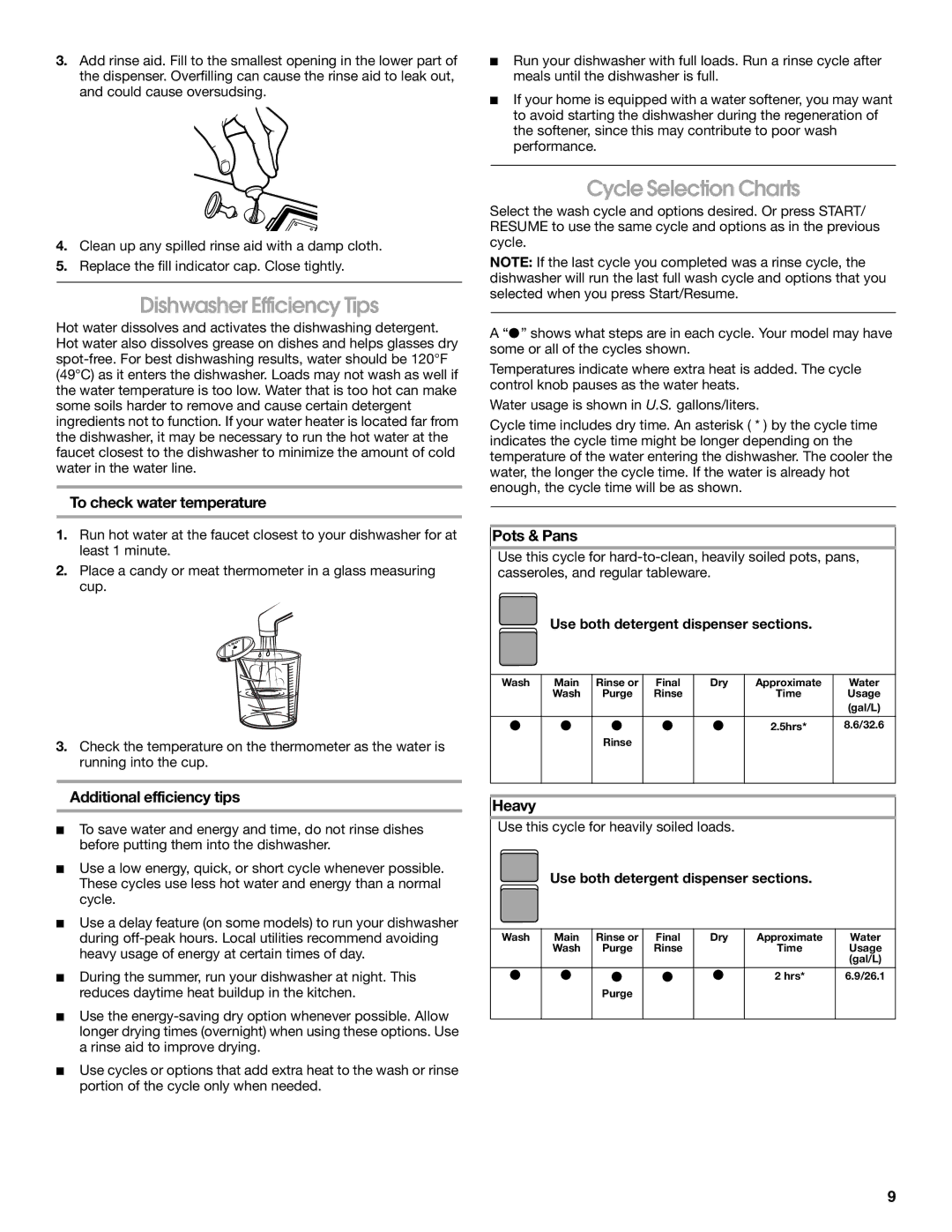
3.Add rinse aid. Fill to the smallest opening in the lower part of the dispenser. Overfilling can cause the rinse aid to leak out, and could cause oversudsing.
4.Clean up any spilled rinse aid with a damp cloth.
5.Replace the fill indicator cap. Close tightly.
Dishwasher Efficiency Tips
Hot water dissolves and activates the dishwashing detergent. Hot water also dissolves grease on dishes and helps glasses dry
To check water temperature
1.Run hot water at the faucet closest to your dishwasher for at least 1 minute.
2.Place a candy or meat thermometer in a glass measuring cup.
3.Check the temperature on the thermometer as the water is running into the cup.
■Run your dishwasher with full loads. Run a rinse cycle after meals until the dishwasher is full.
■If your home is equipped with a water softener, you may want to avoid starting the dishwasher during the regeneration of the softener, since this may contribute to poor wash performance.
Cycle Selection Charts
Select the wash cycle and options desired. Or press START/ RESUME to use the same cycle and options as in the previous cycle.
NOTE: If the last cycle you completed was a rinse cycle, the dishwasher will run the last full wash cycle and options that you selected when you press Start/Resume.
A “●” shows what steps are in each cycle. Your model may have some or all of the cycles shown.
Temperatures indicate where extra heat is added. The cycle control knob pauses as the water heats.
Water usage is shown in U.S. gallons/liters.
Cycle time includes dry time. An asterisk ( * ) by the cycle time indicates the cycle time might be longer depending on the temperature of the water entering the dishwasher. The cooler the water, the longer the cycle time. If the water is already hot enough, the cycle time will be as shown.
Pots & Pans
Use this cycle for
Use both detergent dispenser sections.
Wash | Main | Rinse or | Final | Dry | Approximate | Water |
| Wash | Purge | Rinse |
| Time | Usage |
|
|
|
|
|
| (gal/L) |
|
|
|
|
|
|
|
● | ● | ● | ● | ● | 2.5hrs* | 8.6/32.6 |
|
| Rinse |
|
|
|
|
|
|
|
|
|
|
|
Additional efficiency tips
■To save water and energy and time, do not rinse dishes before putting them into the dishwasher.
■Use a low energy, quick, or short cycle whenever possible. These cycles use less hot water and energy than a normal cycle.
■Use a delay feature (on some models) to run your dishwasher during
■During the summer, run your dishwasher at night. This reduces daytime heat buildup in the kitchen.
■Use the
■Use cycles or options that add extra heat to the wash or rinse portion of the cycle only when needed.
Heavy
Use this cycle for heavily soiled loads.
Use both detergent dispenser sections.
Wash | Main | Rinse or | Final | Dry | Approximate | Water |
| Wash | Purge | Rinse |
| Time | Usage |
|
|
|
|
|
| (gal/L) |
● | ● | ● | ● | ● | 2 hrs* | 6.9/26.1 |
|
| Purge |
|
|
|
|
|
|
|
|
|
|
|
9
